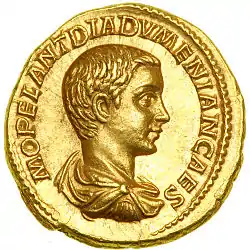Diadumenian
Diadumenian (/daɪˈædʊˌmiːniən/; Latin: Marcus Opellius Antoninus Diadumenianus; 14/19 September 208 – June 218) was the son and co-ruler of Roman Emperor Macrinus. His mother was Nonia Celsa, whose name may be fictitious. Diadumenian became Caesar in May 217. Elagabalus revolted in May 218, and Diadumenian was elevated to co-emperor. After Macrinus was defeated in the Battle of Antioch, on 8 June 218, Diadumenian was sent to the court of Artabanus V to ensure his safety; however, he was captured and executed along the way, in late June.
| Diadumenian | |||||||||
|---|---|---|---|---|---|---|---|---|---|
 An aureus bearing the image of Diadumenian Legend: M OPEL ANT DIADVMENIAN CAES | |||||||||
| Roman emperor | |||||||||
| Augustus | May–June 218 | ||||||||
| Predecessor | Macrinus (co-emperor) | ||||||||
| Successor | Elagabalus | ||||||||
| Caesar | May 217 – May 218 | ||||||||
| Born | 14 September 208 AD | ||||||||
| Died | June 218 AD (age 9) Zeugma (Gaziantep, Turkey) | ||||||||
| |||||||||
| Father | Macrinus | ||||||||
| Mother | Nonia Celsa | ||||||||
History
Diadumenian was born on 14 September 208, named Marcus Opellius Diadumenianus, to Macrinus, the Praetorian Prefect and future emperor of Berber origin,[2] and his possibly fictitious wife Nonia Celsa.[3] Macrinus declared himself emperor on 11 April 217, three days after Emperor Caracalla was assassinated. Shortly after, Diadumenian was elevated to caesar at Zeugma, while his guard was escorting him from Antioch to Mesopotamia to join his father. He was also given the name Antoninus, in honor of the Antonine dynasty, at this time.[4] On 16 May 218 a revolt against him was launched in Emesa by Elagabalus, a relative of Caracalla through his mother, Julia Soaemias, who was Caracalla's cousin. In order to put down the revolt, Macrinus led his legions to the praetorian fort at Apamea. There Macrinus elevated Diadumenian to augustus, making him co-emperor. After Macrinus was defeated by Elagabalus on 8 June 218, at the Battle of Antioch, Macrinus fled north to the Bosporus. Before fleeing he entrusted Diadumenian to loyal servants, instructing them to take him into the Parthian Empire, to the court of Artabanus V, to ensure his safety. Diadumenian was captured en route in Zeugma, and executed in late June.[5][6] His head was brought to Elagabalus, and reportedly kept as a trophy.[7]
Numismatics
While caesar, a large number of coins were struck for Diadumenian, although less than the amount struck for his father. Coins in which he is depicted as augustus are extremely limited, and the only known coins from this time are denarii. This has led to the suggestion, first proposed by Ancient Numismatist Curtis Clay, that a large issue of coins was being made for Diadumenian, however they were quickly melted down when the news of Macrinus' defeat spread. Notably, some eastern provincial coins from the period exist which give Diadumenian the title sebastos, at the time the Greek equivalent of the Roman augustus.[5] In terms of gold coins, Diadumenian has one known style of aureus, bearing his image on the obverse, and displaying Spes standing on the reverse, and one known style of half-aureus, bearing his image on the obverse, and displaying himself holding a sceptre and standard.[8]
References
| Wikimedia Commons has media related to Diadumenianus. |
Citations
- Cooley, p. 496.
- Potter 2004, p. 146.
- Vagi 2000, pp. 289–290.
- Vagi 2000, p. 289.
- Vagi 2000, p. 290.
- Bédoyère 2017, p. 236.
- Bunson 1991, p. 130.
- Friedberg, Friedberg & Friedberg 2017, p. 45.
Bibliography
- Bédoyère, Guy de la (2017). Praetorian: The Rise and Fall of Rome's Imperial Bodyguard. Yale University Press. ISBN 9780300226270.
- Bunson, Matthew (1991). Encyclopedia of the Roman Empire. Facts On File. ISBN 9781438110271.
- Cooley, Alison E. (2012). The Cambridge Manual of Latin Epigraphy. Cambridge University Press. ISBN 978-0-521-84026-2.
- Friedberg, Arthur L.; Friedberg, Ira S.; Friedberg, Robert (2017). Gold Coins of the World - 9th edition: From Ancient Times to the Present. An Illustrated Standard Catlaog with Valuations. Coin & Currency Institute. ISBN 9780871840097.
- Potter, David (2004). The Roman Empire at Bay, AD 180-395. Routledge. ISBN 978-0-415-10057-1.
- Vagi, David L. (2000). Coinage and History of the Roman Empire, c. 82 B.C.- A.D. 480. Fitzroy Dearborn. ISBN 9781579583163.
| Regnal titles | ||
|---|---|---|
| Preceded by Macrinus |
Roman Emperor 218 Served alongside: Macrinus |
Succeeded by Elagabalus |